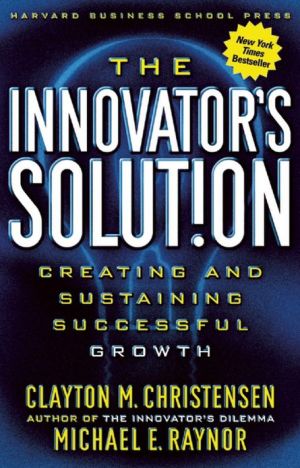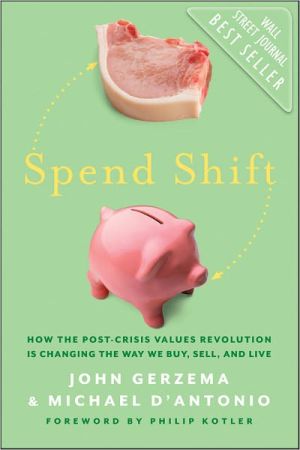The Innovator's Solution: Creating and Sustaining Successful Growth
The Relic Master’s powers are weakening and he and his apprentice Raffi set off to meet the Makers in the City of the Crows and discover why.\ \ \ Staff Favorite of 2003\ With its unique combination of practical advice and counterintuitive insight, this landmark book, sure to become a classic in the field of corporate strategy, demonstrates that today's companies must nurture and harness the power of disruptive innovation if they wish to achieve sustainable, long-term...
Search in google:
Christensen (business administration, Harvard Business School) teams up with the research director of a major professional services firm to explore why business success is so difficult to sustain. After reviewing the conventional wisdom, they discuss innovation as a predictable process and offer theory-based strategies for, and cases of, sustainable growth. One strategy: develop competencies for future success rather than clinging to those that worked in the past. Annotation ©2004 Book News, Inc., Portland, OR September 2003 - Fast Company ....valuable tool for every aspiring upstart--whether you're inside a billion-dollar company or have a billion-dollar glimmer in your eye.
In Gratitude1The Growth Imperative12How Can We Beat Our Most Powerful Competitors?313What Products Will Customers Want to Buy?734Who Are the Best Customers for Our Products?1015Getting the Scope of the Business Right1256How to Avoid Commoditization1497Is Your Organization Capable of Disruptive Growth?1778Managing the Strategy Development Process2139There Is Good Money and There Is Bad Money23510The Role of Senior Executives in Leading New Growth267Epilogue: Passing the Baton285Index293About the Authors303
\ Fast Company....valuable tool for every aspiring upstart--whether you're inside a billion-dollar company or have a billion-dollar glimmer in your eye.\ —September 2003\ \ \ \ \ New York Times"...an absorbing new book..." "...a graceful tour of contemporary management thought." \ —October 19, 2003\ \ \ Denver Business JournalIt is a blueprint to guide managers in each step of identifying and launching disruptive technology or service. December 8, 2003\ \ \ \ \ Financial Times...nothing less than a handbook for managers who would rather disrupt than be disrupted.\ —October 3, 2003\ \ \ \ \ Publishers WeeklyChristensen (The Innovator's Dilemma) analyzes the strategies that allow corporations to successfully grow new businesses and outpace the other players in the marketplace. Christensen's earlier book examined how focusing on profits can destroy even well-run corporations, while this book focuses on companies expanding by being "disruptors" who are able to outpace their entrenched competition. The authors (Christensen is a professor at Harvard Business School and Raynor, a director at Deloitte Research) examine the nine business decisions integral to growth, including product development, organizational structure, financing and key customer base. They cite such companies as IBM, AT&T, Sony, Microsoft and others to illustrate their points. Generally, the writing is clear and specific. For example, in discussing whether a company has the resources necessary for growth, the authors say, "In order to be confident that managers have developed the skills required to succeed at a new assignment, one should examine the sorts of problems they have wrestled with in the past. It is not as important that managers have succeeded with the problem as it is for them to have wrestled with it and developed the skills and intuition for how to meet the challenge successfully the next time around"; they then provide a real-life example of a software company. Similar important strategies give readers insights that they can use in their own workplaces. People looking for quick fixes may find the charts, diagrams and extensive footnotes daunting, but readers familiar with more technical business management tomes will find this one both stimulating and beneficial. (Oct.) Forecast: Given the track record of Christensen's previous book along with extensive publicity and advertising, this one is likely to be a strong seller immediately. Copyright 2003 Reed Business Information.\ \ \ \ \ Soundview Executive Book SummariesRoughly one company in every 10 is able to sustain the kind of growth that translates into an above-average increase in shareholder returns over more than a few years. Once a company's core business has matured, the pursuit of new platforms for growth entails daunting risk - to put it simply, most companies just don't know how to grow, and pursuing growth the wrong way can be worse than no growth at all.\ In The Innovator's Dilemma, Harvard Business School professor Clayton Christensen showed how companies that focus on high-end products for profitable customers can be blindsided by "disruptive" innovations from new competitors - innovations that target low-end customers seeking cheaper products. In The Innovator's Solution, Christensen and co-author Michael Raynor, a director at Deloitte Research, show established companies how to create disruptions rather than being destroyed by them - how to turn innovative ideas into new disruptive products that will lead to long-term profitable growth.\ Managers have long sought ways to predict the outcome of competitive fights based around innovations, but it has, in recent years, become increasingly difficult to do so. The authors write that it's not simply a matter of big companies having the resources to stomp out smaller competitors or to bring about incremental changes or innovations that enable them to outlast the competition. It is the circumstances of innovation that often determine whether incumbent industry leaders or upstart companies win a competitive fight.\ Disruptive innovations do not attempt to bring better products to established customers in existing markets, the authors explain. Instead, they introduce products and services that are not as good as existing products, but which are simpler, more convenient, and less expensive than existing items.\ Disruption often paralyzes industry-leading companies, which are more accustomed to bringing about sustaining innovations. In other words, the authors write, established companies are motivated to focus on pushing innovations to meet the needs of their high-end customers. This leaves the door open for new entrants to target your low-end customers. Eventually, however, the new entrant will make improvements and move up-market - now targeting your high-end customers.\ The authors explain that disruptions create and exist in value networks - contexts within which companies respond profitably to the common needs of a class of customers through evaluating and establishing appropriate processes and channel partners. Two kinds of disruptions can create new value networks:\ 1. New-market disruptions. These disruptions all but create a need in customers, by virtue of their affordability and simplicity of ownership. Canon's desktop photocopiers, for example, made photocopying in one's office (rather than shipping a job out to a print shop) easy, and, as a result, people made a lot more copies. As improvements are made in new-market disruptions, the authors write, the companies that foster them are able to pull customers out of old, mainstream value networks and into new ones.\ 2. Low-end disruptions. Disruptions that take root at the low end of the original, mainstream value network do not create new markets, but simply feature low-cost models that pick off an established firms' least attractive customers. Low-end disruptions typically motivate incumbents into attack mode.\ Launching a single successful disruptive business can create years of profitable growth. Launching a sequence of growth businesses requires leaders to repeatedly use sound theories to make solid key business-building decisions. From these activities, a predictable, repeatable process for identifying, shaping and launching successful growth can coalesce. Such an engine would have four critical components.\ \ Step 1: Start Before You Need To. The authors write that the best time to invest for growth is when the company is growing. To build what will be a respectable growth business in five years' time, you must start now, adding new units to your portfolio of growth businesses as dictated by the growth needs of the corporation five years hence.\ Step 2: Put a Senior Manager in Charge. The authors explain that creating a successful disruptive growth engine requires the careful coaching of the CEO or another senior manager with the confidence and power to exempt a venture from an established corporate process, to declare when different processes need to be created, and to ensure that the criteria being used in resource allocation are appropriate to the circumstance of each venture and the needs of the company.\ Step 3: Create an Expert Team of Movers and Shapers. Ideas often lose their disruptive growth potential in the shaping process that they go through in order to get funded, the authors write. The challenge here is to create a separately operating process through which ideas can be shaped into high-potential disruptions.\ Step 4: Train the Troops. The authors explain that sales, marketing, and engineering employees are best positioned to encounter disruptive growth ideas, and thus should be among the first of the company's "troops" to be trained in the language of sustaining and disruptive innovation. Copyright © 2003 Soundview Executive Book Summaries\ \ \ \ \ \







